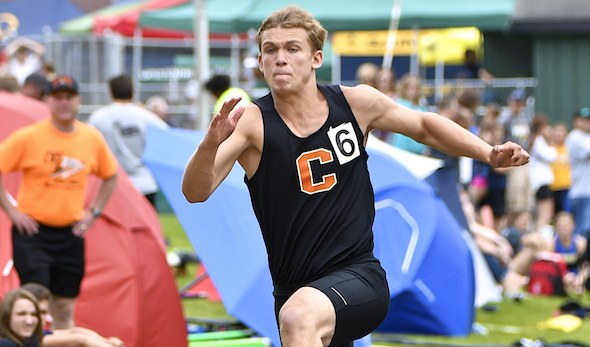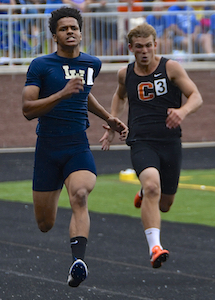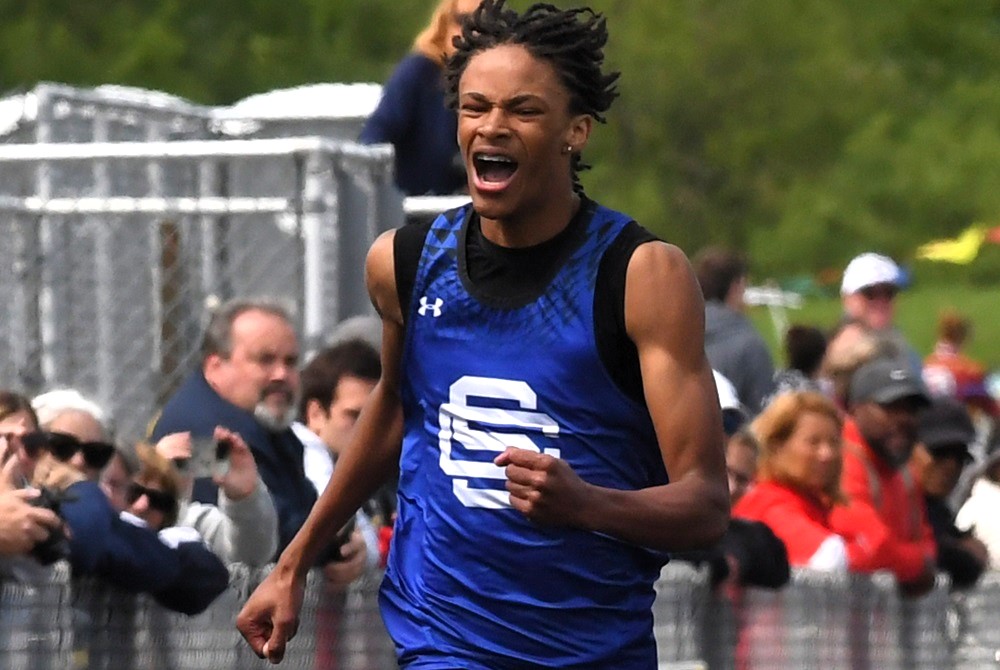
Chesaning Puts Away Win in Final Event
By
Wes Morgan
Special for MHSAA.com
June 3, 2017
COMSTOCK PARK – The boys on the Chesaning track & field team are emotionally spent.
A Saturday saturated with stress gave way to pure bliss as the Indians kept grinding all the way to a Lower Peninsula Division 3 championship at Comstock Park.
Their lead dwindled to a single point, 43-42, with only the 1600-meter relay remaining. The Indians finished in fifth place — the most memorable fifth-place performance, perhaps, in the program’s history.
Chesaning ended the day with 47 points, followed by Hillsdale (42) and Frankenmuth (30).
Hillsdale’s Spencer Eves made things very interesting as his 6-foot, 7-inch performance to win the high jump boosted the Hornets to within a point of the lead with one event remaining.
However, knowing exactly what needed to be done in order to finish off the team title had Chesaning’s mile relay team focused. The mission was pretty clear at that point.
“We had to beat Hillsdale,” Sam Forsyth said. “So we went to work.”
Paxton Ruddy, Hayden Giesken, Forsyth and Zach McFarlan pieced together a time of 3 minutes, 24.03 seconds for fifth place. Hillsdale was 18th and the rest is history.
Chesaning produced a critical victory in the 800 relay when McFarlan, Brady Fraiser, Brandon Keys and Forsyth crossed the line in 1:29.55.
Forsyth gained even more points for the Indians with a first-place distance of 21-6½ in the long jump and a third-place performance in the 200 (22.88). McFarlan was third in the 400 with a personal-best time of 49.32, and the 400 relay team of Anthony Aquado, Fraiser, McFarlan and Keys landed on the all-state team with a seventh-place time of 43.93.
Ruddy also cleared a height of 6 feet, 6 inches for third place overall in the high jump.
 “We knew coming into the meet that we had a chance at being in the top two,” Forsyth said. “But nothing is guaranteed. No matter what you are ranked in an event, you can never completely count on anything in track.
“We knew coming into the meet that we had a chance at being in the top two,” Forsyth said. “But nothing is guaranteed. No matter what you are ranked in an event, you can never completely count on anything in track.
“Today was probably the most stressful and also the most successful day of my life. I couldn’t be happier with the outcome of the meet. Winning titles in the 4x200 and the long jump is great, but bringing home the team title meant the most by far.”
There was certainly a pattern Saturday with wins coming in pairs for others in the field.
Wyoming Lee junior Thomas Robinson couldn’t be stopped in the sprints as he won the 100 in 10.84 and the 200 in 22.04. Bridgman’s Brian Patrick, a senior, dethroned defending 800 champ Anthony Evilsizor (Constantine) with a time of 1:53.81 in personal-record fashion. Patrick also went on to claim the mile championship with a dominant victory (4:11.50) that was a personal record as well.
Evilsizor, who is headed to the Marine Corps now that his high school career is over, tipped his cap to Patrick.
“I just tried to stick on his back to the end and see what happens,” said Evilsizor, whose time of 1:55.50 was a season best. “He didn’t die out. I knew he was the one coming for me. He’s put in the work. I’m not going to complain. It has been fun. I’m happy with second place.”
The hurdle races belonged to Houghton Lake’s Jackson Blanchard, a junior who ran a personal best to win the 110 hurdles (14.81) and his fastest time in the 300 (38.50).
In the throws, Frankenmuth senior Dan Stone muscled his way to a shot put championship with a distance of 60-9¾ (personal best) and a discus title with a throw of 171-00.
PHOTOS: (Top) Chesaning's Sam Forsyth launches during the long jump, which he won to help his team to the overall title. (Middle) Wyoming Lee's Thomas Robinson holds off Forsyth and others in the 200. (Click to see more from HighSchoolSportsScene.com.)

Performance of the Week: Southfield Christian's Brock Morris
June 5, 2025
 Brock Morris ♦ Southfield Christian
Brock Morris ♦ Southfield Christian
Senior ♦ Track & Field
Morris finished an individually-phenomenal day at Saturday's Lower Peninsula Division 4 Finals by helping his teammates make school history. With Southfield Christian trailing leader Kalamazoo Hackett Catholic Prep by three points heading into the final event of the day, Morris anchored the Eagles' 1,600 relay and crossed the finish line first – which, combined with Hackett's third-place finish in the race, gave Morris and his teammates their school's first Finals team championship in track & field by one point.
That victory capped a day that also saw Morris win the 200 and 400-meter open races and run on the winning 800 relay as well. Morris was part of school records in all four of those races this season and the 400 relay as well; the 1,600 relay time of 3:24.36 on Saturday lowered that school record and also included Dylan Taylor-Wilkerson, Robert Brown and Jadon Staten. Morris also ran cross country and played point guard on the boys basketball team. He will study at University of Michigan, majoring in biology, health and society on a pre-medical track.
@mhsaasports 🏃♂️POW: Brock Morris #southfieldchristian #track #finals #winner #1600relay #anchor #part1 #highschoolsports #tiktalk #interview #performanceoftheweek #mistudentaid #fyp #MHSAA ♬ original sound - MHSAA
@mhsaasports 🏃♂️POW: Brock Morris #instagram #chocolatemilk #hidden #talent #emoji #part2 #performanceoftheweek #mistudentaid #fyp #MHSAA ♬ Monkeys Spinning Monkeys - Kevin MacLeod & Kevin The Monkey
Follow the MHSAA on TikTok.
MHSAA.com's "Performance of the Week" features are powered by MI Student Aid, a division within the Department of Lifelong Education, Advancement, and Potential (MiLEAP). MI Student Aid encourages students to pursue postsecondary education by providing access to student financial resources and information. MI Student Aid administers the state’s 529 college savings programs (MET/MESP), as well as scholarship and grant programs that help make college Accessible, Affordable and Attainable for you. Connect with MI Student Aid at www.michigan.gov/mistudentaid and find more information on Facebook and Twitter @mistudentaid.
Previous 2024-25 honorees
May 30: Chloe Qin, Bloomfield Hills Cranbrook Kingswood tennis - Report
May 23: Drew Goik, Bay City Western golf - Report
May 15: Sydney Kuhn, Saginaw Swan Valley track & field - Report
May 8: Ryan Bosch, Fruitport baseball - Report
May 1: Jackson Lam, Kalamazoo Loy Norrix track & field - Report
April 25: Isabelle Horvath, Bangor softball - Report
April 18: Presley Jones, Sterling Heights Stevenson soccer - Report
April 11: Olivia Jasniewicz, Troy soccer - Report
March 27: Katie Spicer, Fowler basketball - Report
March 21: Moses & Markus Blackwell; Warren Lincoln basketball - Report
March 13: Keyshawn Summerville, Lansing Sexton basketball - Report
March 6: Maggie Buurma, Fowlerville wrestling - Report
Feb. 28: Maren Studt, Pontiac Notre Dame Prep skiing - Report
Feb. 21: Olive Krueger, Marquette swimming - Report
Feb. 14: Hunter Lemmon, Fraser swimming - Report
Feb. 7: Aubrey Hillard, Rochester competitive cheer - Report
Jan. 31: Wyatt Spalo, Reed City wrestling - Report
Jan. 24: Olivia Flynn, Harbor Springs basketball - Report
Jan. 17: Levi Rozema, Holland Christian swimming - Report
Jan. 10: McRecco McFadden, Burton Bentley basketball - Report
Dec. 18: Nash Leonard, Bay City Western hockey - Report
Dec. 11: Blake Cosby, Dundee wrestling - Report
Dec. 4: Keaton Hendricks, Zeeland West football - Report
Nov. 29: Kate Simon, East Grand Rapids swimming - Report
Nov. 22: Ella Kokaly, Essexville Garber volleyball - Report
Nov. 15: Caroline Bryan, Grosse Pointe South swimming - Report
Nov. 8: Kaylie Livingston, Whitmore Lake cross country - Report
Oct. 25: Oliver Caldwell, Grand Rapids West Catholic tennis - Report
Oct. 18: Alex Graham, Detroit Cass Tech football - Report
Oct. 11: Victoria Garces, Midland Dow cross country - Report
Oct. 4: Asher Clark, Bay City John Glenn soccer - Report
Sept. 26: Campbell Flynn, Farmington Hills Mercy volleyball - Report
Sept. 19: TJ Hansen, Freeland cross country - Report
Sept. 12: Jordan Peters, Grayling soccer - Report
Sept. 6: Gabe Litzner, Sault Ste. Marie cross country - Report
Aug. 30: Grace Slocum, Traverse City St. Francis golf - Report
(Photo by RunMichigan.com.)

